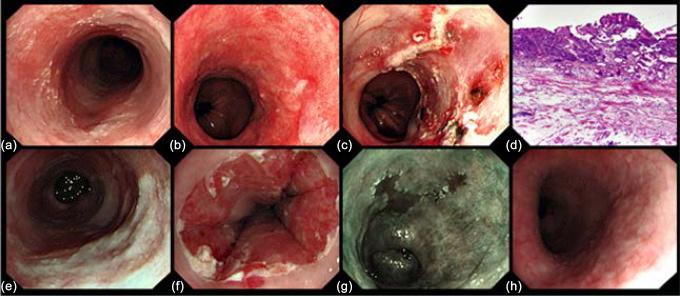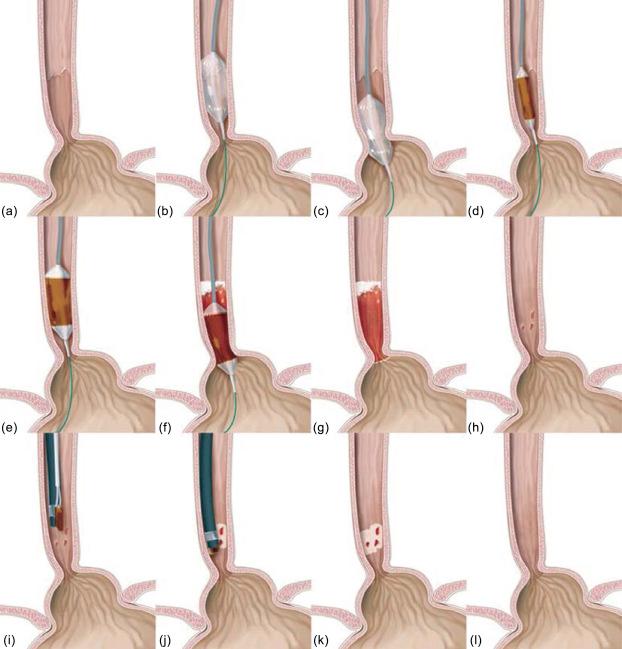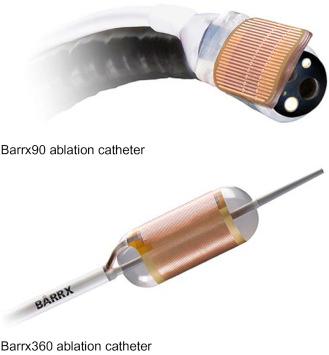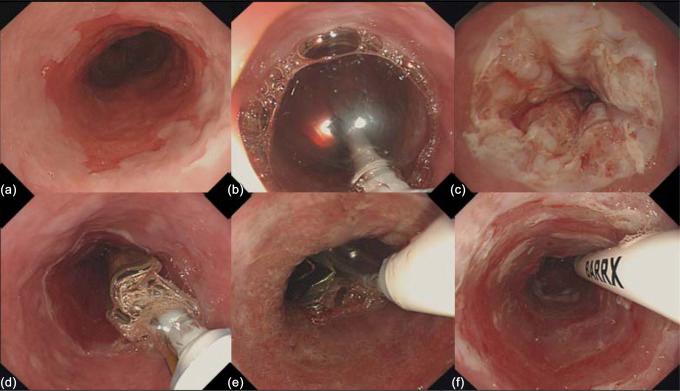Physical Address
304 North Cardinal St.
Dorchester Center, MA 02124
Barrett’s esophagus (BE) occurs when an abnormal, intestinal-type epithelium called “specialized intestinal metaplasia” replaces the stratified squamous epithelium that normally lines the distal esophagus. The condition develops as a consequence of chronic gastroesophageal reflux disease and predisposes to the development of adenocarcinoma of the esophagus .
Traditionally, high-grade dysplasia (HGD) and intramucosal carcinoma (IMC) arising from BE were treated with esophagectomy, while nondysplastic BE and BE with low-grade dysplasia (LGD) were managed with endoscopic surveillance. Problems associated with these approaches included significant morbidity and mortality from esophagectomy , and the risk of missed or interval development of cancer in patients undergoing surveillance . Over the past decades, much research has focused on endoscopic imaging and treatment techniques to improve endoscopic detection and treatment of early esophageal neoplasia.
Radiofrequency ablation (RFA) is an endoscopic treatment modality for eradication of BE. Primary circumferential ablation is performed using a balloon-based bipolar electrode, while secondary treatment of residual Barrett’s mucosa is performed using an endoscope-mounted bipolar electrode on an articulated platform . Studies suggest that this ablation technique is highly effective in removing Barrett’s mucosa and associated dysplasia and in preventing progression of disease, while minimizing the known drawbacks of other ablation techniques (eg, photodynamic therapy (PDT), argon plasma coagulation (APC)) such as esophageal stenosis and subsquamous foci of intestinal metaplasia (IM, “buried Barrett’s”) .
Patients with BE and visible abnormalities containing HGD or IMC may be treated with RFA, but only after endoscopic resection (ER) of all macroscopic lesions.
ER provides a relatively large tissue specimen that allows for histopathological staging of a lesion, enabling optimal selection of patients who are eligible for further endoscopic management . Patients found to have submucosal invading lesions on histology (>T1sm1) have a 15–30% risk of positive local lymph nodes and should be referred for surgery. However, the risk of lymph node involvement is minimal in patients with HGD and IMC limited to the mucosa, with good to moderate differentiation, no signs of lymphatic/vascular invasion, which is radically resected, making these patients candidates for endoscopic management . In addition to staging a lesion, ER also renders the mucosa flat prior to RFA, which helps to ensure that the ablation reaches the muscularis mucosae ( Fig. 11.1 ).

Additional RFA of all remaining Barrett’s mucosa after focal ER of visible lesions is advised to prevent metachronous lesions arising from the residual Barrett’s mucosa after focal ER .
Patients with BE and flat HGD seem to be ideal candidates for RFA, since successful eradication of their dysplastic BE prevents the development of cancer . However, proper patient selection is critical. To ensure that only patients with flat HGD are being treated with RFA monotherapy, several studies have required that patients undergo at least two high-resolution endoscopies with four-quadrant biopsies every 1–2 cm within 2 months prior to RFA to exclude visible lesions or cancer . The use of RFA for flat IMC has only been evaluated in retrospective cohort studies .
There are several arguments that favor the use of RFA for LGD in BE. First, a confirmed histological diagnosis of LGD in BE represents a significant risk for malignant progression. In one study, patients with a consensus diagnosis of LGD had an 85% cumulative risk of progressing to HGD during follow-up, with an annual incidence of 13.4% per patient per year . In patients with a confirmed histological diagnosis of LGD, RFA has also demonstrated to reduce the risk of malignant progression. In a randomized trial (the SURF trial) that was conducted in 9 European centers with 136 patients with a confirmed histological diagnosis of LGD, patients were assigned to RFA treatment or standard endoscopic surveillance (at 6, 12, 24, and 36 months) . The study was terminated early after an interim analysis showing superiority of ablation over surveillance. RFA significantly reduced the risk of progression to HGD or esophageal adenocarcinoma (1.5% vs 26.5%), and RFA also significantly reduced the risk of progression to esophageal adenocarcinoma alone (1.5% vs 8.8%).
In addition, a cost-effectiveness analysis suggested that RFA is the preferred strategy for LGD, but only if the LGD was confirmed (ie, the diagnosis was agreed on by more than one pathologist) and stable (ie, LGD was seen on biopsies obtained at least 6 months apart) .
Given these considerations, many experts believe that the net health benefit of RFA for LGD in BE is favorable, and thus RFA should be available to patients as a primary treatment option, provided that the diagnosis is confirmed by an expert pathologist and that the diagnosis has been confirmed on more than one occasion.
The risk of progression to cancer in patients with nondysplastic BE is small, and no objective markers are available yet to identify patients with an increased risk of developing cancer, although research looking at the risk stratification of nondysplastic BE has shown promising results.
Whether to offer RFA to patients with nondysplastic BE is highly controversial and is influenced by many factors. An argument against RFA in these patients is that the annual risk of malignant progression is low, and many patients with BE are elderly with significant comorbid conditions that limit their life expectancy. Factors that favor treatment include the efficacy and safety profile of RFA and potential cost savings.
For most patients with nondysplastic BE, the net health benefit of RFA may be too low to justify its use. However, RFA could be considered for selected patients (eg, <50 years and a positive family history for esophageal adenocarcinoma or a very long Barrett’s segment).
RFA of BE generally starts with a stepwise circumferential ablation procedure, followed by focal ablation for any residual BE ( Fig. 11.2 ). RFA is performed using the Barrx FLEX system, which is comprised of a number of distinct ablation catheters: the Barrx 360 ablation balloon for circumferential RFA and the Barrx 90/60/Ultra and trough-the-scope device for focal RFA of Barrett’s mucosa.

Circumferential RFA with the Barrx 360 catheter involves the inflation of a balloon-based ablation catheter within the esophagus at the site of the BE. The ablation catheter holds a coiled electrode array on its outer surface, through which radiofrequency energy is applied, resulting in ablation of the mucosa ( Fig. 11.3 ). The Barrx 360 catheter uses the Barrx FLEX energy generator.
Landmark determination . The first step in circumferential ablation is cleaning of the esophageal wall. Initially, this was done with 1% acetylcysteine and flushing with water to remove excessive mucus. A randomized trial has suggested that standard water rinsing through the water jet channel of the endoscope is just as effective . We have therefore abandoned the cleaning with acetylcysteine. Next, the location of the top of the gastric folds and the proximal extent of the BE (including islands) are recorded for reference during the sizing and ablation procedures. A stiff guide wire or metal wire is then introduced, and the endoscope is removed, leaving the guide wire in place.
Esophageal sizing . Once the guide wire is in place, a sizing catheter is connected to the Barrx FLEX generator, calibrated, and introduced over the guide wire. The sizing catheter is used to measure the inner esophageal diameter prior to circumferential ablation. It consists of a 165-cm-long shaft with 1-cm markings and a clear, 4-cm-long noncompliant balloon at its distal end. Upon activation via a footswitch, the sizing balloon is inflated to 4.3 psi (0.30 atm) by the generator using an integrated pressure:volume system. Based on the baseline balloon volume and geometry, the mean esophageal inner diameter is calculated along the entire length of the 4-cm-long balloon.
The sizing procedure can be performed as a “blind” procedure, using the 1-cm scale on the catheter shaft for reference. For the first measurement, the distal end of the balloon is placed 6 cm above the proximal extent of the Barrett’s mucosa. After the first measurement cycle, the catheter is advanced 1 cm, and the sizing process is repeated. This sequence is reiterated until an increase in measured diameter indicates the transition into a hiatal hernia or the stomach.
Ablation catheter selection . Based on the esophageal inner diameter measurements, an appropriate Barrx 360 ablation catheter is selected. The Barrx 360 ablation catheter consists of a 165-cm-long shaft with a balloon at its distal end that contains a 3-cm-long bipolar electrode. The electrode contains 60 electrode rings that alternate in polarity and completely encircle the balloon ( Fig. 11.4 ). The ablation catheter is available in five outer diameters (18, 22, 25, 28, and 31 mm).

The outer diameter of the ablation balloon should be smaller than the narrowest measured esophageal diameter. In patients who underwent prior ER, the ablation catheter should be selected conservatively (by taking an additional step down), keeping in mind that the sizing balloon calculates a mean inner diameter over a length of 4 cm, which might result in an overestimation of the esophageal inner diameter at the site of an ER scar. For example, if the smallest measured diameter is 30 mm, a 28-mm balloon would be appropriate in a patient who had not undergone ER, whereas a 25-mm balloon would be chosen for a patient who had undergone ER .
Ablation regimens . Two different ablation regimens for circumferential ablation are currently in use. The standard ablation regimen consisting of two applications of 12 J/cm 2 with a cleaning phase in between is the most widely used regimen and has been studied extensively. A simplified regimen without a cleaning phase, however, has recently been proven equally effective in a randomized study .
Standard circumferential ablation. The ablation catheter is introduced over the guide wire, followed by the endoscope, which is advanced alongside the ablation catheter. Under endoscopic visualization, the proximal margin of the electrode is placed 1 cm above the most proximal extent of the BE. The ablation catheter is then inflated to 3 psi. Upon activation, radiofrequency energy is delivered to the electrode (12 J/cm 2 ). Energy delivery typically lasts less than 1.5 seconds, after which the balloon automatically deflates. Moving distally, the balloon is repositioned, allowing a small amount of overlap with the previous ablation zone (5–10 mm). We treat the entire BE segment in a single session, irrespective of its length . After the entire length of BE has undergone one ablation cycle, the guide wire, ablation catheter, and endoscope are removed. Once outside the patient, the catheter is inflated and any adherent coagulum on the electrode surface is removed using wet gauze. A soft distal attachment cap is then fitted on the tip of the endoscope, and the scope is reintroduced into the patient. The soft extending rim of the cap is used to gently slough off the coagulum from the esophageal wall in the ablation zone. After most of the coagulum has been removed with the cap, forceful spraying of water through a spraying catheter using a high-pressure pistol can be used to wash off residual coagulum. After the cleaning procedure, the entire length of BE is ablated again using the same energy settings. A circumferential ablation treatment using the Barrx 360 catheter takes approximately 30–40 minutes, depending on the length of the BE.
We would advise using the standard regimen in patients with a complex or tortuous BE (eg, a relative stenosis, narrowing at the ER site). The cleaning step of the standard regimen is a good way to assess the completeness of the first ablation pass and allows for necessary adjustments of the balloon position to treat skipped zones.
Simplified circumferential ablation. The ablation catheter is introduced over the guide wire, followed by the endoscope, which is advanced alongside the ablation catheter. Under endoscopic visualization, the proximal margin of the electrode is placed 1 cm above the most proximal extent of the BE. The ablation catheter is then inflated to 3 psi. Upon activation, radiofrequency energy is delivered to the electrode (12 J/cm 2 ). After the balloon has deflated, it is immediately inflated and activated for a second hit, while keeping the catheter in the same position. After two ablations of 12 J/cm 2 , the catheter is moved distally and repositioned, allowing a small amount of overlap with the previous ablation zone (5–10 mm). A randomized trial demonstrated that this simplified regimen omitting the cleaning in between ablations is easier and faster than the standard regimen, but equally safe and effective . The procedure time was reduced to 25 minutes. At 3 months after the circumferential ablation, the percentage of Barrett’s surface regression did not differ significantly between those who underwent a simplified ablation and those who underwent a standard ablation. In addition, complete eradication of neoplasia and IM was similar in the two groups (100% and 90%, respectively).

Based on these results, we currently use the simplified protocol in patients with uncomplicated BE (without scarring or stenosis).
Become a Clinical Tree membership for Full access and enjoy Unlimited articles
If you are a member. Log in here